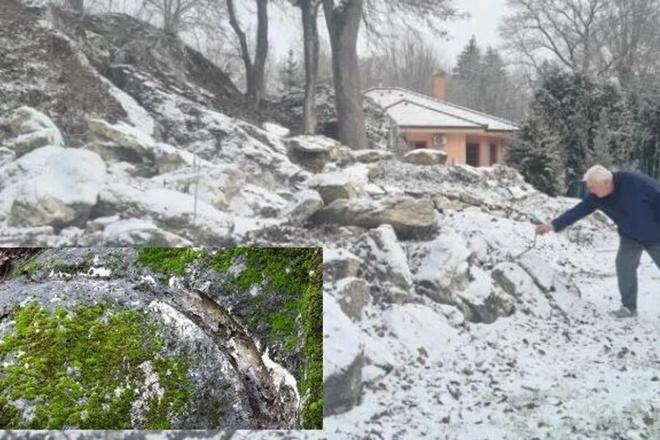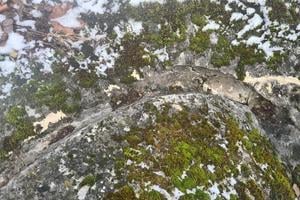Juraj Lauko’s property, situated near natural mineral springs, has long been of archaeological interest. Previous excavations have uncovered a fortified settlement from the early Bronze Age and what is believed to be a shaman’s dwelling—findings considered rare in Europe.
The site has been inhabited since ancient times, largely due to the mineral springs. Recently, the archaeological team working there was joined by palaeontologists, who confirmed that a rock imprint visible on Lauko’s property could be hundreds of thousands of years old, reports My Levice. They also dispelled a previous misconception, ruling out the possibility that the imprint belonged to a mammoth. Experts from the Slovak Academy of Sciences now agree it is an even rarer find—likely from another prehistoric giant.
Such discoveries are exceptional in Slovakia, with only around ten known sites yielding similar finds.
Shamanic site behind the house
A large travertine mound occupies part of Lauko’s garden in Santovka, southern Slovakia. The mound was formed over time through the gradual accumulation of minerals. Santovka, a village near Levice, is known for its mineral springs, which supply the local swimming pool and are bottled at a nearby factory. One of the springs even emerges on Lauko’s private land.
“In the 1960s and 1970s, Santovka’s travertine was mined for use in monuments and building materials. The mining ceased in 1976,” Lauko explains, pointing to the unusual formation behind his house. At that time, the area was open land, and Lauko’s family built their home there 15 years ago.
It was not until archaeologists began their work that Lauko learned the mound in his garden could have been a Neolithic shamanic site. “A pitcher from the Linear Pottery culture, dating back 5,500 years, was found here, along with part of a stone axe, charred antler, a wild boar’s skull, an auroch’s horn, and bones from a deer and a mammoth, as well as a tooth,” he recalls, adding that some of these items are now stored at his home, though they have been officially recorded.

A tusk from a prehistoric animal
The most significant find on Lauko’s property, however, is the imprint of a tusk from a prehistoric animal, suggesting it measured around one metre in length. The print appeared in the lower section of the travertine mound, which had been partially quarried by workers.
For years, it was believed to belong to a mammoth. “It wasn’t until palaeontologists arrived, created a cast, and confirmed the animal’s identity,” Lauko explains.
The experts soon determined that the imprint did not belong to a mammoth but rather to a forest elephant. While mammoth tusks are typically curved at the end, forest elephant tusks are only slightly bent, as was the case with this imprint. The forest elephant was one of the largest known elephant species, weighing up to 13 tonnes, and once roamed Europe and Western Asia.
Lauko believes the animal did not die on his property. “It was probably hunted by prehistoric humans. The tusk was left on the rock, which was lower back then. Either the hunter forgot it there, or he knew that the minerals would gradually ‘consume’ it,” he suggests, explaining how minerals from the spring settled over time and eventually engulfed the tusk.

Much rarer find than initially thought
Two years ago, in January, Ján Madarás, director of the Earth Science Institute at the Slovak Academy of Sciences, and palaeontologist Csaba Tóth visited Santovka. They examined the imprint preserved in the travertine formation behind Lauko’s house.
“A plaster cast of the tusk is displayed in the small municipal museum at Santovka town hall. Before our visit, the tusk was labelled as that of a mammoth. Tóth, the leading expert on fossil elephants in Slovakia, correctly identified it as a much rarer find: the tusk of a forest elephant,” Madarás explained.
“During the Ice Age, mammoths were fairly common, but during the warmer interglacial periods, forest elephants roamed Europe. Such a discovery is extraordinary,” he said.
“Based on the slight curvature, we believe the tusk belonged to Palaeoloxodon antiquus, the forest elephant. This species has been found at only around ten locations in Slovakia, making it far rarer than mammoths, whose remains have been discovered at approximately 350 sites,” Tóth confirmed.
He also noted the challenge of dating these finds. “This warm-adapted species has been in Europe since the early Middle Pleistocene, around 800,000 to 700,000 years ago. Most of the Slovak finds are likely from warmer phases of the Middle Pleistocene, between 500,000 and 200,000 years ago. The youngest known find is from Gánovce, dating to around 100,000 to 90,000 years ago,” he added, offering an approximate timeline.
Forest elephants were also present in western and southern Europe during the last glacial period, up until around 45,000 years ago. “The climate in central Europe at that time was much harsher, colder, and drier, but due to the lack of precise dating, it is still possible that the species may have occasionally wandered into this region during short warmer periods of the last glaciation,” he speculated.


 Rare discovery in the garden of the house. (source: Jana Némethová)
Rare discovery in the garden of the house. (source: Jana Némethová)



